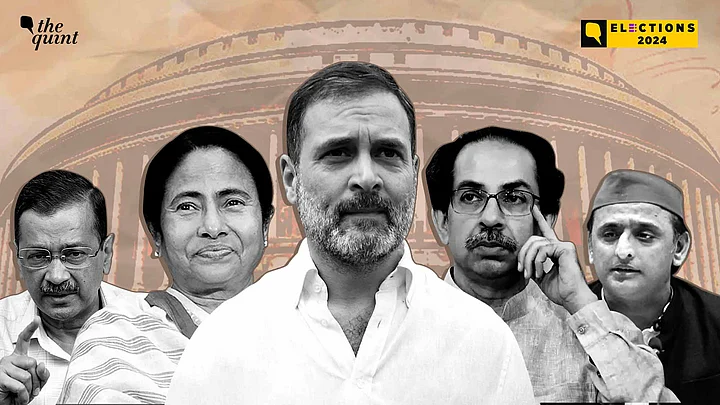The INDIA bloc will continue to work together “in and outside Parliament”, said Congress President Mallikarjun Kharge in the Congress Working Committee (CWC) meeting held on 8 June, the first such meet after the 2024 Lok Sabha election results. The INDIA bloc parties stood at a tally of 234 seats, with many alliance partners, including the Congress, surpassing the predictions of most of the exit polls. With the PM Narendra Modi-led NDA government now sworn in, the INDIA bloc partners are expected to keep the alliance working together nationally, with TMC leader Mamata Banerjee even hinting that their eyes are still on government formation. “The BJP is forming the government undemocratically and illegally. Today, the INDIA bloc may not have staked a claim to form the government, but that doesn't mean tomorrow it won't stake a claim. Let’s wait for some time,” Banerjee said days after the election results.
But much of the internal dynamics of the INDIA bloc will now be influenced by the performance of each alliance partner in the elections. Sources said that INDIA leaders will meet soon to assess how each partner performed in the Lok Sabha polls, and whether the allotment of seats was fair or not.
How INDIA Partners Performed
The performance of the major INDIA bloc parties was as the following. The Congress had a strike rate of 30 per cent, winning 99 of the 328 seats it contested. While Congress was the only opposition party contesting elections in almost all states, this was still the lowest number of seats the party has ever contested in its history. The Congress' strike rate was far better than the strike rate of parties like the Aam Aadmi Party (AAP) which had a strike rate of 13 per cent, and the Rashtriya Janata Dal (RJD) which had a strike rate of 17 per cent.
The best performance, in terms of strike rate, was of the DMK, which won a 100 per cent of the seats it contested in Tamil Nadu.
Some of the biggest surprises were sprung up by Maharashtra, where the INDIA bloc’s alliance partners had a strike rate of 80 per cent (NCPSP) and 43 pe cent (SSUBT). The Samajwadi Party also upped its performance significantly, with a strike rate of 59 per cent in Uttar Pradesh.
Future For Assembly Polls And The National Picture
Multiple INDIA bloc leaders, like Banerjee, have asserted that the Lok Sabha results are a success of the alliance and implied that the bloc will attempt government formation in the future. This means that at least nationally, the opposition alliance has taken shape and is likely to continue acting in tandem in the parliament.
However, the bigger question is whether these regional alliance partnerships are likely to continue in state assembly elections or not.
The AAP has already ruled out the possibility of an alliance with the Congress in the 2025 Delhi Assembly polls. The decision was taken in the party’s organisational team two days after the election results, headed by Gopal Rai. The AAP won just 3 of the 22 seats it contested in, spread across 5 states: Punjab, Delhi, Gujarat, Haryana and Goa. All 3 of its wins have come from Punjab, where it is the ruling party.
Other parties like the DMK, which has traditionally had an alliance with Congress in state assemblies too, is likely to continue with the partnership. Mamata Banerjee’s TMC doesn’t get along too well with the Congress’ West Bengal unit, didn’t contest the 2021 state elections in alliance either and is highly unlikely to do so in the near future.
In Uttar Pradesh, where Congress had won just 1 seat in the 2019 elections, the party increased its tally to 6, of the 17 seats it contested on. The Samajwadi Party, which contested on the remaining 62 seats, won 37, a strike rate of 59 per cent. While numerically, it’s clear that the Congress dragged down the overall tally of the alliance in Uttar Pradesh. However, vote transfer, especially of the Dalit community to the Samajwadi Party due to its alliance with Congress is not something that can be quantified. The CSDS-Lokniti survey showed that the Yadav and Muslim voters consolidated behind the INDIA coalition along with a significant share of non-Jatav Dalit voters. The CSDS survey also revealed that Rahul Gandhi was marginally ahead of Narendra Modi as the PM choice. The results thus also signals a revival for the cadre of the Congress party in the state, making it likely that the SP and Congress will have to work together in the state assembly polls.
The Maharashtra assembly polls, also scheduled for later in 2024, along with Haryana and Delhi are where the alliance’s future is most uncertain, despite performing well. Hours after the Lok Sabha results on 4 June, rumors began to surface that the Shiv Sena (UBT) is in touch with the NDA. The party dismissed all such rumors and said they will continue with the INDIA bloc. “Maharashtra is always tricky. Now more than ever with so many party splits. Ideally, the alliance should continue as the Lok Sabha polls have proven people prefer the original over the copies. But state and central polls always require a different set of factors to be considered,” said a Congress source.
(At The Quint, we question everything. Play an active role in shaping our journalism by becoming a member today.)
